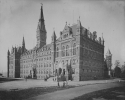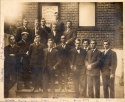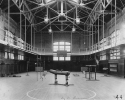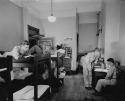Items in the Exhibition:
Healy Hall as viewed from the east side, 1900
Work began on Healy Hall in late 1877. It was to have space for laboratories and a new library, as well as classrooms, dormitory rooms, and a meeting area for alumni. The firm of J.L. Smithmeyer & Company, who also designed the main building of the Library of Congress, drew up the plans. Their product, massive in scale, is 312 feet long and 95 feet wide with a clock tower that rises 200 feet. With Healy Hall’s opening, the University doubled the total square footage of its buildings. Healy was the first of our buildings to face the city rather than the river and it has been suggested that President Patrick F. Healy, S.J., who planned the building, deliberately oriented it as a signal that Georgetown should be viewed, from that point on, as an educational institution of national importance.
Student room in Healy Hall, 1901
For the 1901-1902 academic year, students paid $400 for tuition, board, lodging in a shared dormitory room, washing, and mending. Private rooms, such as this, were available for an additional charge of $80.
Baseball game on the Georgetown College Field, with Healy Hall and Old North seen in the background, 1900
Photograph by C.M. Bell, 463 & 465 Pennsylvania Ave., Washington, D.C.
Team sports did not emerge on campus until after the Civil War. By 1869, the College boasted two baseball clubs, the Stonewalls and the Quicksteps. Games were played on the field that later became Copley Lawn. It has been suggested that origins of the word, Hoya, which formed part of the college yell or cheer, Hoya! Hoya! Saxa!, can be linked to the Stonewalls baseball club. The theory is this: a student using a mixture of Greek and Latin (which were emphasized by the curriculum) dubbed the Stonewalls, Hoia Saxa. Hoia is the Greek neuter plural for what or what a, while saxa is the Latin neuter plural for large or rough rocks. Taken together, Hoya Saxa literally means what rocks – the suggestion being that the players were as hard as rocks. Others have speculated that Hoya Saxa referred not to the team but to its surroundings - home plate was near the stonewall which still stands along 37th Street.
First year class of the Georgetown University Medical School, 1906
In 1849, there was only one medical school in Washington, the Medical Department of Columbian College, which controlled access to the city's lone hospital, as well as to membership in the newly established national regulatory agency, the American Medical Association. Seeking to break this monopoly, four local doctors (Noble Young, Flodoardo Howard, Charles H. Liebermann, and Johnson Eliot) petitioned Georgetown President James Ryder, S.J., to begin a Medical Department under the auspices of the College. Within two weeks, Father Ryder appointed the four petitioners to professorships. Classes began in 1850 in a building on the corner of F & 12th Streets in northwest Washington and the first students graduated in 1852. The School moved to its present quarters on Reservoir Road in 1930.
Gatekeeper James McNerhany, ca. 1910
A handwritten note on the back of this photograph reads: Mr. Mac - James McNerhany, who had been for many years the faithful watchman and gatekeeper of G.T. College. He had been a confederate soldier. Died at the G. U. Hospital, May 27, 1910.
Interior of Ryan Gym, 1910
Photograph by John Brosnan, S.J.
Ryan Gym, a gift of Ida M. Ryan of New York, opened in October 1906 and was designed to serve a student body of around 250. Note the elevated running track around its perimeter which created shooting problems for the basketball players. A Hoya article of January 10, 1940, reports the track’s removal and notes: This structure had long been a hindrance to basketball players . . . as students know, it was impossible to make a shot from the corner of the court as the ball was blocked by the overhanging balcony.
Ryan served as a practice venue for the basketball squad for 45 years. Home games were moved there in 1914. Prior to that, they had been played at a number of off-campus venues: Washington Light Infantry Armory (15th & Pennsylvania Avenue, NW); Convention Hall (5th & K Streets NW); Odd Fellows Hall (8th & D Streets, NW); and Arcade Rink (3134 14th Street, NW). The last home game was played in Ryan on February 21, 1931 – a 29-23 loss to the Brooklyn Knights of Columbus. The Gym is now incorporated into the Davis Performing Arts Center.
Visitors from the Visitation Academy and Georgetown students on the steps of Healy Hall, 1911
In 1799, a formal religious community according to the Visitandine rule and a school for girls were founded near what are now 35th & P Streets, NW, under the guidance of Georgetown President Fr. Leonard Neale. The school became known as The Young Ladies’ Academy of the Visitation at Georgetown.
Given the school’s geographical proximity to the College, it was natural that associations would form between the two institutions. By the 1850's, the older students at the College were hosting dances that included young ladies from their own families and from Visitation. Ties grew stronger after a junior college was established at Visitation in 1919.
School of Nursing Class of 1912
Photograph by Scherer Studio, 1207 F St., NW, Washington, D.C.
Women have studied at Georgetown continuously since the founding of the Nursing School in 1903. The School was established to provide support for the University Hospital which opened in 1898. The Hospital was managed by the Sisters of St. Francis but, as the facility expanded, the Order was not able to supply enough Sisters to staff it. The University, therefore, created a training school for nurses run by the Order.
Students were initially required to live at the Hospital as there were no other women students at Georgetown and, as a consequence, no women’s dorm. Nursing education began as a three year diploma program. In 1944, a five year program was introduced with two academic and three clinical years. The same year, the Georgetown University Training School for Nurses officially became the Georgetown University School of Nursing. In 1951, the five year program gave way to an integrated four year degree.
Dramatic Association, 1913. Pictured in the center of the last row is Edmund A. Walsh, S.J.
Plays have been put on by Georgetown students since the 1790s. In 1853, a dramatic troupe was officially established on campus. The first article of the Association’s constitution reads: This association shall be called the Dramatic Association of Georgetown College. It professes to hold Elocution as the primary object of its cultivation. In 1910, after a period of obscurity, the Dramatic Association was reorganized through the efforts of Edmund A. Walsh, S.J., for whom our School of Foreign Service is now named. The first production put on by the revitalized group was All the Comforts of Home, a farce by William Gillette. The show was so well received that Fr. Walsh, working with the Alumni Association, arranged to have it put on in New York, in the Astor Room of the Waldorf Astoria Hotel.
The Association adopted a new name in 1919 – the Mask and Bauble Club. The name was chosen to reflect that the Club would perform both tragedies and comedies.
Football game against the University of Virginia on the Georgetown College Field, 1914
Photograph by Seabrook Bros., 906 F Street, Washington, D.C.
The University of Virginia was the opponent in Georgetown’s first intercollegiate football game held in the fall of 1889. The Hoyas defeated the visiting Cavaliers, 34-0, beginning a spirited rivalry. The annual Georgetown-Virginia game became the highlight of the football season, attracting as many as 5,000 spectators to campus.
Football was a very different game at this time. According to newspaper accounts, several games in the 1890s were played in near riot conditions. In the October 23, 1915, Georgetown game against Army at West Point, circumstances required the referee to issue a ruling that biting, while not explicitly prohibited by the rules, did constitute unnecessary roughness.
Exterior view of the Law School, 1915
This building at 506-508 E Street, NW, was the fifth home of the Law School. The Law Department of Georgetown College opened in 1870 with twenty‑five students, including one from Cuba, and a faculty of six. Tuition was $50 per year. Initially a two-year evening school, most of the students worked by day in government agencies. Early lectures were held in rented space at the American Colonization Building on Pennsylvania Avenue, site of the present East Wing of the National Gallery of Art, but the school would change location five times until it settled in its current home on New Jersey Avenue in 1971. In 1898, course work for the Bachelor of Laws degree was expanded to three years, a change that was made well ahead of most law schools in the country.
First class in the Foreign Service School, with Edmund A. Walsh, S.J., pictured to the right, 1919
The Foreign Service School began classes in February 1919, with an initial enrollment of 62. Within five years over 500 students were enrolled. The School had been the idea of Dr. Constantine E. McGuire, Assistant Secretary‑General of the Inter‑American High Commission in Washington. In 1918, seeing a shortage of professionals trained in foreign commerce and diplomacy, Dr. McGuire proposed to Georgetown President John B. Creeden, S.J., that a school be set up to provide such training. Father Creeden appointed Edmund A. Walsh, S.J., as the School’s Regent and charged him with its organization. Father Walsh guided the School until his death in 1956 and in 1957 it was named in his honor.
As enrollments grew, greater attention was given to specific areas of concentration within the School. Particular emphasis on foreign language development and international business led to the creation of the School of Languages and Linguistics in 1949 and the School of Business Administration in 1957.
Marshal Ferdinand Foch on the porch of Old North, 11/16/1921
Photograph by Simons, Washington News Service, 10 Jackson Place, NW, Washington D.C.
Marshal Foch (1851-1929), Commander in Chief of the Allied armies during World War I, was France’s representative to the Limitation of Armament Conference held in Washington, D.C., on November 11, 1921. He was awarded an honorary Doctorate of Canon and Civil Law by Georgetown on November 16, 1921 and was also presented with a gold sword, a gift from all the Jesuit colleges in the United States.
Stonemasons working on White-Gravenor, 12/2/1932
In the 1920’s and 1930’s, new facilities including New North, Copley and White‑Gravenor had to be built to accommodate a student body that nearly doubled in size. The University had made sound financial decisions and did not lose significant amounts when the stock market crashed. As a result, construction work on campus was able to continue during the Depression.
Dental surgery at Georgetown University, 1940
Photograph by Underwood & Underwood, 1230 Connecticut Avenue, Washington, D.C.
In 1901, Georgetown acquired the Washington Dental College, the first dental college in the city. It was re-named the Dental Department of Georgetown University and one of its founders, Dr. William N. Cogan, was elected dean. In 1920, the first X-ray machine was installed. The School was initially housed in an addition to the School of Medicine building at 920 H Street, NW, with both Schools moving onto campus in 1930. Applications to the School began to decline in the late 1970's, a pattern that reflected a national trend, and in 1987 the decision was made to phase out the School by the summer of 1990.
Army Specialist Training Corps cadets in a dorm room in Ryan Hall during World War II
Photograph by Sidney R. Bayne, Washington, D.C.
The impact of World War II was felt in many ways on campus. An accelerated course of study was introduced in July 1942. This consisted of a year-round quarterly term system which enabled students to complete the four-year undergraduate schedule in two and a half years. Enrollment dropped sharply. However, in April 1943, the War Department designated the University as one of a select number around the country to house the newly-designed Army Specialized Training Program (ASTP) and one of only 31 universities to have a Specialized Training and Reassignment (STAR) program. As a result, more than 75% of students enrolled during the 1943-1944 year were military servicemen. Buildings that normally housed 600 students were occupied by nearly 1500. After the War, the GI Bill made higher education possible for so many that temporary buildings had to be erected and substantial numbers of new faculty hired.
Riggs Library, 1960
Photograph by Georgetown University News Service/Bob Young, Jr.
From 1891 to 1970, Riggs served as the main University library. A rare example of Victorian, cast-iron prefabrication, it is 40 feet wide, by 60 feet long, by 32 feet high. Washington banker Elisha Francis Riggs (1851-1910) donated $10,000 to establish the library as a memorial to his father, George W. Riggs, and his brother, T. Lawrason Riggs, who had attended Georgetown from 1874 to 1876.
After the completion of Lauinger Library in 1970, Riggs stood vacant for a time. A proposal was even made that the space be divided into offices. Fortunately, it was decided to leave Riggs intact and to designate it for use by the Fine Arts Department. In 1981, after the Fine Arts Department had vacated the space, a restoration project was begun. Original paint color and gilt designs were recreated and research in the University Archives photographic collections led to the replication of the original gas-light fixtures, complete with etched glass shades, adapted for electric lights. The project received the First Award in Preservation and Restoration from the Washington Metropolitan Chapter of the American Institute of Architects. According to the AIA jury, the elegant Victorian interior has been sensitively restored to its polychromatic glory. Today, Riggs, one of the few remaining cast-iron libraries in the country, is used as a reception space and continues to serve its original purpose of housing books.
Vice President Lyndon B. Johnson receiving the John Carroll Award, 10/12/1963. Pictured, left to right: President of the Alumni Association William Catherwood; Vice President Lyndon B. Johnson; and Georgetown President Edward B. Bunn, S.J.
The 1963 John Carroll Awards Dinner was held in the Waldorf-Astoria Hotel in New York. The John Carroll Award was established by the Georgetown University Alumni Association in 1951 to honor alumni whose achievements exemplify the ideals and traditions of Georgetown University and its founder, Archbishop John Carroll. It is the highest honor bestowed by the Association. Lyndon Johnson was eligible to receive the award because he had attended Georgetown's Law School in the fall of 1934.
Students gathered in the Quadrangle after hearing news of the assassination of President John F. Kennedy, 11/22/1963
Photograph by Georgetown University News Service/Bob Young, Jr.
Students gathered to hear mass for President John F. Kennedy, who had once lived only three blocks from campus, immediately after word was received of his assassination. The mass was said by John F. Devine, S.J., Director of the Student Personnel Office, from the porch of Old North.
Senator Joseph Biden (D-Del.), the youngest member of the Senate Foreign Relations Committee, discusses Congress and foreign policy at an informal seminar sponsored by the Georgetown Lecture Fund, 2/22/1977
President Timothy S. Healy, S.J., awards the President's Medal to Men's Basketball Coach John Thompson, Jr., in Gaston Hall, 4/24/1982
The citation for the medal, written by President Healy, reads in part: His classroom is first of all a basketball court and his subject a game. But the real tools of his trade are the blending of fifteen young people into a working unit, the jazz-like improvisation which his game demands, the discipline required to work body and mind together into a dance as intricate as any ever invented by the mind of man, and finally the beauty of the body’s movement which must condition the soul. It is a teaching as old as the games of Greece, and its goal is the hard moral base of citizenship.
In January 1999, after 26 and a half seasons, John Thompson resigned as Head Men’s Basketball Coach. He had led Georgetown teams to 20 NCAA Tournaments, seven Big East Championships, three Final Four Appearances, and one National Championship.
President Timothy S. Healy, S.J., (right) escorts the Prime Minister of Great Britain Margaret Thatcher down the steps of Healy Hall, after a ceremony to award her an honorary degree, 2/27/1981
Photograph by Bill Auth
1983-1984 Hoya National Champions
On April 2, 1984, Georgetown met Houston in the National Basketball Championships played in the Seattle Kingdome. The 84-75 Georgetown victory was a triumph of teamwork, domination, and intimidation. Making use of his team’s remarkable depth, Coach Thompson was able to keep sending in fresh players and Houston was unable to counter them. Five Hoyas scored in double figures: Reggie Williams scored 19; David Wingate16; Michael Graham 14; Michael Jackson 11; and Patrick Ewing 10. Ewing also led the team in rebounding with nine boards and was named the tournament MVP. Houston Center Akeem Olajuwon commented after the game: They do everything a great team should do. They don’t care who takes the shots, who scores. That’s the difference. They aren’t a selfish team.
Curated by Lynn Conway, University Archivist


























